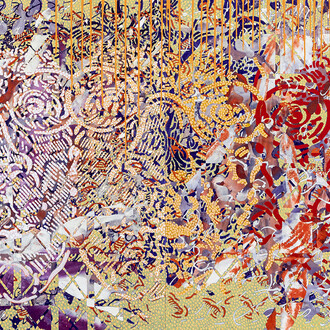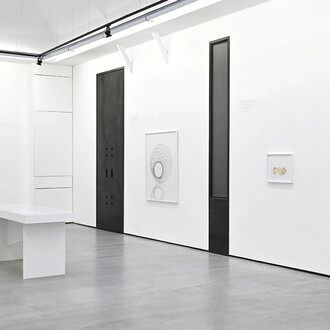Watercolour is often ranked as the underdog within the artistic media hierarchy, with oil firmly at the top. It suffers the connotations of the amateur artist, which belies its real magic as a rich, ancient, complex and unpredictable medium. The 18th century was its heyday, predicated on the invention of the portable paint box. Chaperoned leisured ladies could paint in delicate swathes of colour in the manner of plein-air artists such as Turner, Cotman, Towne and Constable. According to Kiefer, ‘with watercolour, you cannot work by levels, you do one level and that’s it. You do more and it becomes a failure’[i].
Strange then when we associate him with depictions of catastrophe, war and climate change, macho-emotional works epitomised by massive perspectival canvases of straw and debris which counter his ‘Extases féminines’. Here, there is another register to Kiefer as his romantic, lyrical landscapes testify. These paintings offer an insight into his more intimate watercolours. Rodin’s muscular, solid bronzes are similarly tempered by erotic pencil and wash drawings made from the 1890s-1917[ii]. However, Rodin’s figures are passive-swathed in titillating transparencies, without expression or character, his women float and tempt through ghostly anonymity, conforming to preconceptions.
They sleepwalk compared to Kiefer’s often-named, seemingly eternal, mythological, sexual women, offering an alternative facet of the male gaze. Berthe Morisot embraces a female perspective in Repos (Jeune fille endormie) 1892, the model with eyes closed and mouth open, perhaps relating to her 1885 diary entry[iii]. ‘Saw yesterday at a curiosity shop in the faubourg Saint-Germain an engraving after Boucher that was most improper and yet adorably graceful […] one can imagine nothing more voluptuous than a woman sleeping, her bosom swollen with love’, (translated from the French; d’une extreme inconvenance et pourtant d’une grace adorable)[iv]. These (presumably) post-coital, and post-orgasmic images by Francois Boucher and Morisot suggest both male and female interpretations[v]. Kiefer’s watercolours attempt to grasp that same moment of the fleeting extase in febrile, vibrant, graphic imagery. The celebratory works appear to interpret and depict a series of different types of female orgasm.
La Vie en Rose en Extase
Kiefer splices his ecstatic women with luscious roses bunched into bouquets of bursting colour. Roses may symbolise love but there remains a disparity between love and sex. Napoleon’s lover Josephine created a rose garden with 250 varieties of rose at her Château de Malmaison. DiMaggio famously continued to send roses to Monroe’s Los Angeles crypt three times a week for 20 years after her death. Vendors of single red roses roam city restaurants hawking this ubiquitous bloom. Do these love equivalents ease potential sexual encounters? Kiefer’s explosive blooms provide an amalgam of these condensed ideas and co-opt the colourful rose as counter-protagonists within the collaged diptych dialogue.
Jean-Noël Vuarnet’s time at the Villa Medici (1977-79) inspired his book Extases féminines (1980) and consequently, Kiefer, to portray women who cavort, jive, tumble and twist, seem to row and pivot within blue skies in a world of soaring, screeching joy, suggesting that la petite mort is like being in the clouds or hovering above the sea. Kiefer invents dreams to catch a memory, a souvenir, sometimes a part of love, sometimes part of independence. He appears to be trying to illustrate that brief moment and by offering us the flower as an atmospheric companion, he sites these gymnastic portrayals within a garden of delight.
Happy as a clam, Venus lies within a nacrous shell, her open thighs mimicking the open bivalve, her exposed vagina recalling Courbet’s L’Origine du monde (1866) rather than Botticelli’s Birth of Venus (1485–86). A figure flies elegantly in a yogic backbend above a huge crater evoking the land of dreams - will she be engulfed or simply reflected on the surface? Another performs exotic dances in the air. Oskar Kokoschka painted The Bride of the Wind (Die Windsbraut) in 1913-14; a self-portrait with his lover Alma Mahler beside him, the two almost embalmed by the swirling sea surround. Kiefer’s version (2014) is set firmly on land, a lonesome tree framed by a glorious sky. His blonde-haired, red-lipped bride was also alone in space, the paper joins separating her from the pulsing sky and open fields. Brünhilde (2017) appears twice; a side-view and a full-on arse as she balances agile upon a wooden trunk.
Similarly, Danaë (Δανάη, both 2017) receives a golden shower, both figures appear tense as they await the impact of splatter; it’s all action. The three Marmorklippen (2015) on buff ground focus on the head and shoulders. These works make the connection between the flailing hair and open mouth; the moan, the shout, that cry, all are implicated by a shuddering marbled line, suggesting that electricity escapes the body once the peak has been attained. Semele (2013), stationary, is drenched in yellow streaks and golden blobs, consumed by lightning flames produced when she forces her lover Zeus to reveal his identity - a heavenly way to communicate the explosion within her head as her body comes to a climax.
Likewise, Daphne (2013) stands, her feet planted on the ground, holding a branch that trails behind her. This is not Bernini’s masterful interpretation of the Greek myth, when running from Apollo, her marble body dissolves through transformative escape into a wooden laurel world; the leaves and branches invading her body. This Daphne is a pink post-sauna woman, relaxed, placid, calm but with sex on the agenda and in the air. Delicate strands of pencil underpin the forms; her pretty bosom peaks are rounded. A tuft of dispersed black suggests a pubis, and a crack of cadmium chasing up her leg leads our eye. These twigs float without pencil delineation; pure, trailing paint, performing the narrative, invoking a myth, and showing us the story.
Kiefer’s watercolours rejoice in the materiality of humanity, and the possibility of escape from the everyday through self-fulfilment: turbulent visions created with a medium known for its uncontrollable nature. It’s a celebration of ‘les extases féminines’: coming up roses.
(Text by Liz Rideal)
















